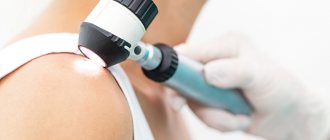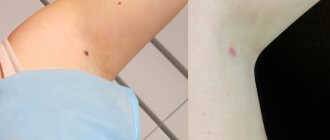Radio wave removal of moles is a surgical and atraumatic way to eliminate cosmetic defects, as well as potentially dangerous formations on the skin, without the risk of damage to laterally and deeper located organs and tissues.
In modern clinics, radio wave removal of moles is carried out with a special device, the operating principle of which is based on the use of a high-frequency wave generator. The use of radioknife and removal of moles using thermal energy as a tool for tissue excision is recognized as the most effective and gentle procedure of all currently existing.
The radio wave method of tissue separation was proposed in the middle of the last century by Irving Elman (American surgeon and radio engineer). Since then, the removal of moles using the radiosurgical method has been continuously improved and achieved unprecedented success.
Laser exposure
Today this method remains one of the most popular. Many people prefer to resort to it rather than conventional surgery using a surgical scalpel. The laser effect does not leave any marks on the skin, which means that after healing the patient will not have unsightly scars or scars. Using a laser, you can easily remove a mole on your face without fear of any negative consequences. Why is this method so good? Does he have hidden weaknesses?
- No chance of bleeding
The laser acts on the skin very carefully and cannot injure it. Therefore, the likelihood of bleeding is excluded. People who are afraid of blood should opt for this method. The laser penetrates deeply into the epidermis and eliminates only pathogenic cells, preventing them from spreading to healthy tissue. Many people have already been able to solve their aesthetic problem with the help of a laser.
- Speed of the procedure
This operation lasts no more than fifteen minutes. The patient will not need much time to come to his senses. As a rule, immediately after the end of the manipulation you can go home without hindrance. The speed of the procedure is due to the fact that the laser acts on tissue extremely gently, without destroying healthy cells or causing them any harm. The patient can sit quietly in the doctor’s chair for the specified time. At the same time, he will not experience any physical discomfort. Fear of the surgical intervention itself, as a rule, also quickly passes as soon as a person begins to compare and analyze his sensations.
- Pain medication required
In order for the operation itself to take place in the most comfortable conditions, it is necessary to use painkillers. These drugs will allow the patient to feel as comfortable as possible during tumor removal. Especially if you need to remove several small moles located next to each other, this method is absolutely irreplaceable. The use of an anesthetic does not in any way detract from the advantages of the chosen method, since in itself it is recognized as one of the most effective and safe methods of excision of any tumors on the skin.
- Impossibility of analysis
Unfortunately, removing moles with a laser eliminates the possibility of performing the necessary tests. The peculiarities of the procedure itself do not contribute to this. However, most people, as a rule, do not strive to conduct such research. Doctors immediately warn that taking tests will be unrealistic. This is perhaps the only disadvantage of the laser method.
Online magazine about choosing the best goods and services
31.07.2019 18:03:14
Expert: Sergey Brill
Removal of moles and other growths on the skin can be performed with the Surgitron device and laser. We analyzed each method, highlighting their pros, cons and features.
| Apparatus | Advantages | Flaws |
| Surgitron | Availability, low cost; Fast rehabilitation period; Few contraindications; Biopsy can be performed; Tissue healing in 5-7 days | There is a risk of relapse; Not suitable for large growths; |
| Laser | Exposure time - up to 5 minutes; Bloodless; No risk of infection; Growths on the mucous membrane and face can be removed; There is no risk of relapse; No scars or cicatrices remain | More contraindications;Higher risk of side effects |
Description of the Surgitron technique
Surgitron is a radio wave method for removing moles, when pigment formations are exposed to high-frequency waves. The technique can be carried out both in a hospital setting and at home. Due to the risk of complications, it is better to contact the clinic. First you need to determine the nature of the formation, eliminating possible contraindications.
Surgitron or radio knife is used in dermatology, cosmetology, gynecology and urology. More often, the technique is used to remove warts and papillomas. The device is also used for cervical erosions and for bloodless biopsy. Radioknife helps get rid of scarring after abortion and childbirth. It prevents consequences such as pain, swelling and infection.
Side effects
Removing growths with Surgitron is a safe procedure, but much depends on the professionalism of the doctor. If you make a mistake, a burn with scarring is possible.
How the procedure works
Surgitron works on the principle of non-contact tissue cutting. During the procedure, the doctor can control the strength and depth of penetration. High-frequency waves can remove the growth without damaging surrounding healthy tissue.
During radiation, the cells evaporate, and simultaneous soldering of the vessels occurs to prevent bleeding. Coagulation also helps prevent infection.
How does Surgitron remove tumors?
- An antiseptic is applied to the skin.
- Local anesthesia is performed.
- The doctor uses a loop waveguide to remove most of the growth.
- The remains of the formation are removed by a ball waveguide.
- After leveling the wound, the skin is treated with an antiseptic.
If oncology is suspected, the growth is cut off at the root, after which the tissue is sent for histological examination. After this technique, a scar remains. When removing layer-by-layer with smooth movements, either no traces remain or they are barely noticeable.
Who is it suitable for?
The rationality of using Surgitron is assessed by the doctor individually. The technique is well suited for small growths of benign origin.
The device can remove the following types of tumors:
- warts – occur when infected with the papilloma virus;
- condylomas - can be pointed and wide, appear on the mucous membrane and skin;
- moles are pigmented formations of different colors and shapes;
- keratosis - thickening of the stratum corneum;
- hyperplasia – accompanied by increased cell division;
- dermafibrosis - have a keratinized or smooth surface, raised above the skin;
- spider veins - occur when blood vessels dilate;
- Molluscum contagiosum is an infectious disease, a type of chickenpox.
All these formations can be eliminated with the help of Surgitron, unless there are contraindications. What is also important is that the compactness of the device allows for precise removal of growths in hard-to-reach areas.
Description of the laser method
Laser removal of tumors occurs due to vaporization, the ability of the beam to cauterize tissue, evaporating moisture. Modern equipment makes it possible to control the intensity and time of radiation. The laser beam acts with precise focusing without damaging adjacent tissues.
Today, laser technology in cosmetology is in demand, safe and effective. The procedure eliminates bleeding and the risk of infection.
Which device is better - laser or radio wave?
The Surgitron device has proven itself well for the removal of moles, papillomas and warts, as well as for the treatment of cervical erosion. Like the laser method, radio wave exposure is non-traumatic and has a precise impact on the desired area.
The radio knife should be chosen to eliminate small growths, and the laser method is suitable for large tumors.
The choice of device depends on the specific situation. You first need to assess the nature of the growth and collect information about possible contraindications, which is done by the doctor who will perform the procedure. Regarding the price, the Surgitron device will cost less than a laser one.
Source: //expertology.ru/sravnivaem-apparaty-surgitron-ili-lazer-opredelyaem-luchshiy/
Use of radio waves
The radio wave method of influencing any skin tumors is recognized by doctors as very effective. It is better for them to remove moles that look somewhat convex and sloppy. It is important that the nevus itself is not too bulky in size. Thousands of people have already decided to remove various growths using radio wave therapy. This method has a lot of fans today. The advantages and disadvantages of this method are given below.
- Preservation of healthy cells
When exposed to the human body, radio waves do not affect healthy cells, but directly affect only the pathogenic structures themselves. That is, only aggressive microorganisms that have a destructive effect die directly. The radio wave method allows you to most effectively combat growths and nevi. If a person has several moles that need to be removed, this method is perfect. The radio wave method allows you to preserve healthy cells, unlike other methods, which can cause significant damage to the skin. That is why it is recognized as the safest and, at the same time, very effective.
- Convex moles
Not all excision methods are suitable for raised moles. Outwardly, such neoplasms do not look very neat and require careful and close attention. With the help of radio wave therapy, you can completely get rid of moles. In this case, no unpleasant marks will remain on the body. The good thing about this method is that it allows you to quickly and painlessly remove any tumors that prevent you from feeling confident and attractive. Convex moles will no longer pose any difficulty. The use of radio waves is one of the safest methods of influencing growths, warts, moles and has virtually no contraindications.
Reasons for the operation
Formations that appear on the body may not always be a source of danger. They do not have to be removed; they do not cause discomfort. One of the reasons why patients undergo surgery is aesthetic inconvenience, for example, the location of a nevus on the face, neck, or in places of constant contact with underwear.
The operation is mandatory if:
- malignancy has been diagnosed, i.e. the formation has become malignant;
- open bleeding or suppuration due to injury;
- there is a risk of blood poisoning;
- nevus changes size, shape or color;
- there is a burning sensation, pain, itching;
- new spots appear in the area of the existing spots;
- hair loss mole.
Growths on the body, especially large ones, should be under constant supervision. In such places there should be no discomfort and constant friction due to tight clothing. Under no circumstances should you try to remove the nodes yourself at home, as a dangerous consequence could be blood cancer or dangerous blood infection.
Moles can appear in both adults and children. In adolescence, the issue of surgical intervention is decided strictly individually. It is recommended that removal be carried out before or after puberty. This is due to the fact that adolescents have overly active sebaceous glands, which can cause clogged pores and cause wounds to heal slowly.
The radio wave method is a complete , painless treatment for patients and is an alternative to laser therapy. Only a doctor will determine what is the best way to get rid of an unwanted mole.
What is radio wave removal of tumors?
The essence of the method is that a device, using an electrode emitting high-frequency radio waves, cuts off the growth at its base. In this case, all vessels are sealed and bleeding stops, thereby eliminating the risk of infection of the wound.
The procedure is performed under local anesthesia. The doctor selects the necessary attachment for the radio knife, it depends on the size and location of the formation. For example, to remove a pedunculated papilloma, you need a loop attachment. The upper part of the growth is pulled off with tweezers, and at the base it is cut off with a loop tip. The tumor is excised completely, while the specialist monitors that healthy areas of the skin are not damaged. The radio wave method can be used on any part of the body, but is not used on mucous membranes.
The advantages include:
- Safety – there is no risk of infection;
- Bloodlessness - radio waves coagulate blood vessels, so there is no bleeding;
- Speed – the whole procedure takes no more than 20 minutes;
- Possibility to take tumor tissue for histological examination.
However, it is important to note that there are several disadvantages to this method. Firstly, removal is carried out only of those neoplasms that rise above the skin or have a stalk or base (papillomas, warts, fibromas). For example, radio waves are not suitable for removing flat moles. Secondly, after excision, a small scar may remain on the skin. But in this case, much depends on the size of the pathology and the experience of the doctor who performs the procedure. Thirdly, if the growth cells are not completely removed, relapse and the appearance of a new formation in the same place are possible.
It is important for patients to know that there are a number of contraindications for this procedure:
- Heart and lung diseases;
- Infectious diseases;
- Hepatitis and diabetes mellitus;
- Oncological diseases;
- Pregnancy and lactation period;
- Period of menstruation;
- Inflammations on the skin.
A wound remains at the site of the procedure, which is covered with a crust. During the week, you should minimize contact with water, do not apply cosmetics containing alcohol, and also do not visit a solarium and do not expose the removal site to direct UV rays. You need to wait until the crust disappears on its own. Then, for 2 months, smear the remaining mark with healing and anti-scar ointments. In this case, you can avoid a scar at the site of the electrode impact.
The cost of radio wave removal of tumors can vary from 500 to 2500 rubles. The price depends on the type, shape, location and category of complexity of the growth.
What should you pay attention to when changing moles?
The main signs of an “unhealthy” mole.
- Lack of symmetry.
- The edge is curved, the contours are unclear.
- Atypical color, coloring is not uniform.
- The diameter is more than six millimeters.
- Strong elevation above the skin.
- Various inflammations - redness, crusts, itching.
If more than two or more factors are detected, then you need to be diagnosed by an oncologist. Under no circumstances should you treat yourself or get rid of moles and other formations at home.
If you find “suspicious” moles, do not hesitate to consult a doctor
Laser therapy in the removal of skin tumors
The targeted effect of a laser beam allows you to target the pathological area without affecting healthy tissue. The doctor independently controls the depth of penetration of the laser beam and the radiation power. This approach makes the procedure low-traumatic and virtually painless.
How does the procedure work?
Typically, the entire complex of manipulations aimed at removing a nevus takes about 15 minutes. Immediately before removal, the patient is given local anesthesia, after which the specialist begins work. One or more skin tumors can be removed in one procedure; the result depends on the size and area of localization of the nevus. The versatility of the laser lies in the fact that there are no hard-to-reach places for it; it is used both on the skin and mucous membranes. Using a laser beam, moles, papillomas, warts, fibromas, hemangiomas, and atheromas of any size and shape are removed.
Pros and cons of laser therapy
pros
- speed of the procedure;
- short period of skin recovery;
- all manipulations are performed on an outpatient basis;
- bloodlessness, since the laser seals small vessels and capillaries during exposure;
- safety and low probability of infection, since there is no direct contact of the laser beam with the patient’s blood;
- the risk of tumor recurrence is negligible.
Indications and contraindications
High-frequency waves are generated by special equipment, which, due to the presence of its distinctive characteristics, is called a radio knife.
The main indications for the intended use of such high-frequency equipment are not only benign skin formations (nevi), but also other types of neoplasms that appear on the surface of the skin, including:
- papillomas;
- condylomas;
- keratosis;
- warts
The radio knife cannot be used to remove moles in the following cases:
- Malignancy of neoplasms on the surface of the skin.
- The presence in the patient’s body of pacemakers, which are installed for cardiac diseases.
- Skin diseases, inflammatory in nature, in a chronic form.
- Viral infection of the skin surface, for example, herpes.
- Pregnancy or breastfeeding period.
Removal of skin tumors using radio waves
Along with laser therapy, the radio wave method is used to remove moles. Its essence boils down to the effect on the mole of a device emitting high-frequency radio waves. This technique is suitable for removing raised moles with uneven edges. An important factor in radio wave removal is that the mole should not be too large in size. The radio wave technique is suitable for removing several skin growths in one session.
How does the procedure work?
No special preparation is required for exposure to radio waves. If a specialist has doubts about the nature of the neoplasm, he recommends consulting an oncologist.
Before starting the manipulations, the specialist conducts a visual inspection of the mole, assesses its size and decides on the frequency of the wave with which the neoplasm will be removed. The area where the nevus is located is numbed with an anesthetic injection, cream or gel. After the anesthetic begins to act, the immediate removal of the skin lesion begins.
During the procedure, the doctor places a loop attachment on the nevus, then lifts the upper part of the growth with tweezers and cuts off the growth at the very base. The mole is excised completely, while the doctor monitors that healthy areas of the skin are not damaged. The radio wave removal method is applicable to any area of the skin, but it is not used on mucous membranes.
On the first day after removal, a crust forms at the site of the growth, which will fall off on its own within a week. In place of the fallen off crust, delicate pink skin forms, which must be protected from exposure to aggressive ultraviolet rays (direct sunlight or solarium).
Advantages and disadvantages of the technique
Advantages
- safety and painlessness of the procedure;
- lack of blood, as the radioknife seals the vessels;
- short duration of the operation, usually no more than 20 minutes;
- the ability to take neoplasm tissue for histological examination.
Flaws
- The radio wave method is suitable for removing tumors raised on the skin;
- relapse occurs in approximately 30% of cases;
- scars may occur at the site of removal.
Skin care after using radio wave technique
After excision of a mole, a wound remains on the skin, which over time becomes covered with a crust. You cannot remove or peel off the crust; you must wait until it falls off on its own. For 7 days, it is necessary to minimize contact with water, exclude alcohol-containing cosmetics, and also avoid solariums and tanning in direct sunlight. For 2 months, it is recommended to apply healing and anti-scar ointments to the remaining mark; this will help avoid the appearance of a scar at the site of the electrode impact.
Contraindications to removing moles using radio waves
The radio wave technique is considered effective and safe, but this does not exclude the list of contraindications to its use:
- pathologies of the heart and bronchopulmonary system;
- infectious diseases in the acute phase;
- diabetes;
- viral hepatitis and other liver pathologies;
- oncological diseases;
- rashes on the skin in the area affected by the laser;
- The procedure is contraindicated for women during menstruation, pregnancy and lactation.
Proper skin care after the procedure
During the regeneration period, it is important to observe the following hygiene rules for the treated area of the epithelium:
- Use an antiseptic several times a day . However, the use of potassium permanganate, iodine, brilliant green or calendula will only complicate healing.
- Avoid damaging the affected area with clothing or shoes. As a protective measure, it is advisable to use a bactericidal patch.
- wet for several days , and cover the treated area while taking a shower.
- Do not touch the scab or scratch the affected area.
- Do not relax in a bathhouse, sauna, or swimming pool for several weeks after the manipulation.
- Avoid aggressive exposure to sunlight . Before going outside, cover the area after the mole with a bandage or treat it with sunscreen.
- If lumps appear , changes in skin tone, or bleeding occur, you should immediately consult a specialist.
The recovery period after removing a mole with a radioknife lasts only a few weeks, but during the entire regeneration period it is important to correctly follow the doctor’s instructions.
Which method is better for removing moles - laser or radio waves?
Each of the presented methods has its own pros and cons. The choice of removal method depends on the general condition of the patient, his medical history, the shape and size of the skin tumor. For example, the radio wave technique is applicable to growths that are convex and rise above the skin. However, the laser, in turn, easily copes with both hanging and flat nevi. The radio wave technique is appropriate only on the skin, but the laser can also be used on mucous membranes. If the specialist is not sufficiently qualified, a radio knife can damage healthy areas, and this prolongs the healing process and increases the likelihood of scars and cicatrices; in the case of a laser, this is excluded due to the point effect. Based on a comparison of methods, many experts recommend removing moles with a laser, since it is considered the safest and least traumatic method.
Differences
These methods also have differences:
- Surgitron, like a scalpel, excises the layers of skin along with the neoplasm, and the laser cauterizes the layers of the epidermis layer by layer.
- The exposure time of the radio knife is 5-20 minutes ; the laser acts more quickly - it takes no more than 2 minutes .
- Surgitron eliminates the tumor along with the area of the epidermis, and the laser acts specifically on the tumor without affecting neighboring areas of the skin.
- If the defect is eliminated using surgitron, then the removed tissue can be sent to the laboratory for histological analysis to find out whether the formation was malignant or benign. During laser exposure, tissues are burned, and it is impossible to send them for further research.
- The cost of the methods also varies - the price of the laser method starts from 200 rubles , and removal using surgitron starts from 1000 rubles .
How to remove a mole with Surgitron
The operation of surgitron is based on the action of high-frequency radio waves on pathological areas of the body. Atypical tissues resist this effect. The process releases thermal energy. The growths begin to collapse. The main advantage of the method is the absence of burns, injuries, purulent and hemorrhagic complications.
The doctor determines indications and contraindications for radio wave therapy.
The procedure consists of the following steps:
- The patient is given local anesthesia.
- The specialist evaluates the shape and size of the mole. The doctor selects the desired frequency of the radio wave.
- Using a radio knife, the doctor cuts the nevus, stops the bleeding, and carries out disinfection. The listed actions are carried out by the device itself.
- At the end of the procedure, a brown crust remains. Doctors do not recommend getting it wet for a week. It protects the wound from bacterial and viral flora. The crust disappears after a few days. Do not lubricate it with cosmetics.









